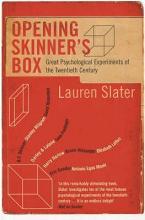
Across the street from me is a beautiful church with emerald moss tamped between the stones. Sometimes I go to this church, for the singing. After Sunday sermons, a collection basket gets passed around. One day, while in the midst of reading the stories of smoke and stabbing, I noticed that the basket, before reaching the first person in the first pew, was already mysteriously plied with a flurry of folded dollar bills. A few weeks later, my sister, a bartender, confessed to me how she “salts” her tip cup at the beginning of each evening with a few fives and tens: “I get a lot more tips that way,” she told me. “People think people before them have given. And so they do too.” We are driven by imitation.
... Do giraffes … give a lot of sideways glances, before eating from the top of that tree? Do primates depend on the reactions of the pack before figuring out how to proceed? Here’s a tale about turkeys: Turkey mothers know to care for their young only when they hear the babies make a very particular chirping sound. If the chicks fail to make that sound, the mother is suboptimally cued, and the chicks die. So strong is the influence of that particular social cue that scientists have been able to attach tape recordings of the chicks’ cries onto polecats, the turkey’s prime predator, and thus fool the mother into maternity while she is murdered by the wired beast. Ethologists claim social cuing, or fixed patterns of behaviour, in animals like birds is instinctual, a pattern of the brain’s paste and circuits, while in humans it exists in another plane, a product of learning. Scientists doubt we have any particular “cuing” gene. I, for one, think we might. I remember being pregnant and how shocked I was that my body could make a baby, a whole separate other, with no conscious instruction from me. How did it know what to do? Cells, it turns out, are engaged in continuous conversation with one another, sending each other chemical cues to then set off a looping cascade of events that, over time, become particular human parts and then the complex whole. The human heart is made when one single cell cues another, and then that cell nudges yet another, and so here is the hand, the tongue, the bones, which are fine white wires eventually sheathed with the silk of flesh. In my case, the cues were all correct and so I have my girl, and she is good.

Add new comment